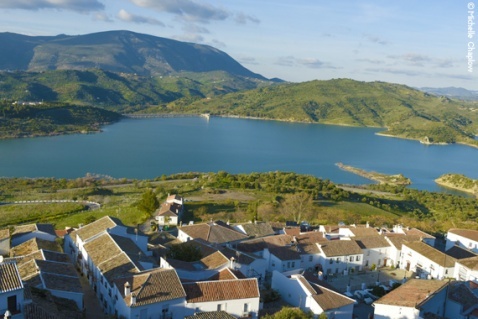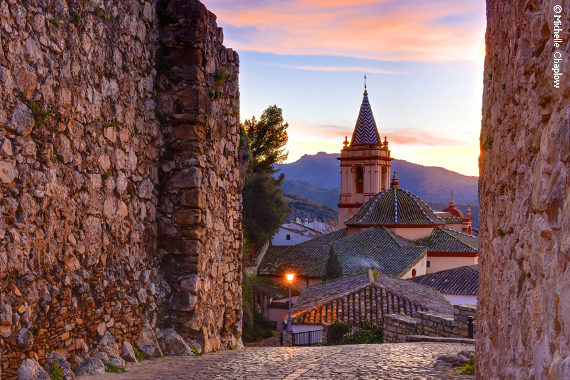
Views from the village of Zahara de la Sierra to the turquoise reservoir |
|
Zahara de la Sierra - Things to SEE
by Chris Chaplow
Plaza Mayor
As with most towns, this square is the Zahara's main focus and heart, and a pretty place to stop in a bar to watch the world go by. Around the square are the Church of Santa María de la Meza, tourist office, Town Hall, souvenir shop, mirador (viewing spot) terrace bar, and the actual mirador which offers splendid views over the reservoir, the countryside and across to the village of Olvera in the distance. Don't miss the stone fountain in the centre - a water trough with a central street light.

Church of Santa María de la Meza
This 18th century church is built with a Latin cross floor plan in the baroque style, with three naves and a central dome; its defining feature is the main wooden baroque altarpiece. Within the church is a small museo parroquial (parish museum) which includes ornate velvet robes, donated belen (nativity scene) figures and silver artifacts. The cliffs immediately behind and above the church are very steep, offering an interesting photo from the centre of the square.
Tourist Office
This is not a tourist office for the town, but one of the information points for the Natural Park of Grazalema, with maps, books and local produce.
Puerta de la Villa (Town Gate)
You will find this at the end of Calle Fuerte, where the path up to the castle starts. Today the 'arch' part does not exist, but you can still see the impressive two-storey pillar bases on each side - some of this stone is original. Dating from the 15th or 16th century, the arch was later reconstructed and included a clock, but was blown up by fleeing French troops in August 1812. Recent restoration is confined to the lowest section, about one metre high.
Castle
After all those tantalising glimpses on the road to Zahara, you will want to visit the castle about the town. The 'castle' is actually a six-hectare area on the rocky hill, known as the 'Villa Arabe' or 'Villa Medieval'; its crowning glory is the Homage Tower. The path starts at the car park on the roof of Hotel de la Villa and is wide with a handrail in good condition. It is a steep climb through the cacti and pines with wild flowers, prickly pear and almond trees. Initially you pass by foundations of unmarked buildings clinging on the more level slopes.
The first historic building looks like the homage tower but is the Iglesia Major and you still have a long way to climb. Be careful here as the birds nest in the walls and make a mess on the path or persons below. The supporting buttresses are modern but the walls are original.
Iglesia Major was constructed in 1407 on the instruction of Infante Don Fernando de Antequera (later Fernando I King of Aragon) and blessed by Don Sancho de Rojas, Bishop of Palencia. It was constructed on the foundations of a mosque, as recorded in the chronicles of the day and confirmed in recent excavations. It was a church of rectangular plan with two naves in the mudejar style.
During the 17th century the faithful stopped coming to the church in favour of two shrines, San Juan de Letran and San Francisco situated in the newer town outside the walls. By 1704 only Semana Santa and Corpus Christi were celebrated in the church. The new bell tower, commissioned in 1616 had become a legend as it still was not complete in 1734 when the church was demolished. The original Las Iglesias Santa Maria de la Mesa in the main square has been rebuilt into a 'Centro de Interpretacion Zahara' which is only open for special occasions.
Torre del Homenaje was the building constructed at the highest point in the castle, 605m above sea level. The exterior, adapted to the terrain, is almost square, measuring 12m by 12.6m with rounded corners. Inside the building is divided into four chambers with arched ceilings. On the lower floor in the entrance, with a large stone whose purpose is unknown. An interior staircase leads to the upper floor with a fireplace and chimney. As well as a lookout this tower served as the last refuge in the event that the rest of the castle fell to the enemy.
Chapel of San Juan de Letran
Built on the site of an earlier chapel in 1956, it is a single nave construction with arched façade crowned with three bell towers.
Fountains
Zahara de la Sierra has three drinking water fountains in the village. "El Altabacar' on the road to Grazalema next to Molino El Vinculo, "La Higuera" next to the municipal swimming pool where the municipal lavadera (communal washing area) survives, and "La Calera" in the direction of Ribera de Arroyomolinos.